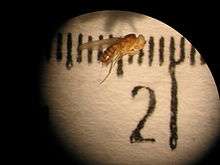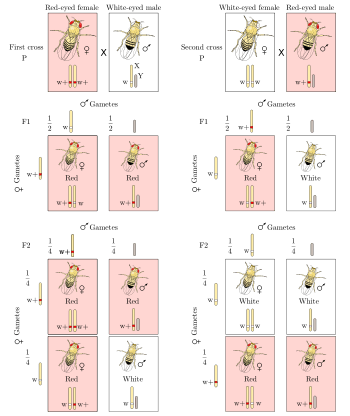White (mutation)

White, abbreviated w, was the first sex-linked mutation ever discovered in the fruit fly Drosophila melanogaster. In 1910 Thomas Hunt Morgan and Lilian Vaughan Morgan collected a single male white-eyed mutant from a population of Drosophila melanogaster fruit flies, which usually have dark brick red compound eyes. Upon crossing this male with wild-type female flies, they found that the offspring did not conform to the expectations of Mendelian inheritance.[1] The first generation (the F1) produced 1,237 red-eyed offspring and three white-eyed flies, all males. The second generation (the F2) produced 2,459 red-eyed females, 1,011 red-eyed males, and 782 white-eyed males. Further experimental crosses led them to the conclusion that this mutation was somehow physically connected to the "factor" that determined sex in Drosophila. This led to the discovery of sex linkage, in which the gene for a trait is found on a sex chromosome. Morgan named this trait white, now abbreviated w.[2] Flies carrying the white allele/ white gene are frequently used to introduce high school and college students to genetics.

Function
The protein coded by white functions as an ATP-binding cassette (ABC) transporter. It carries the precursors of the red and brown eye color pigments, guanine and tryptophan, into the developing eyes during pupation.[4] White-eyed flies are not blind, instead they are easily temporarily blinded by bright light at certain frequencies because they lack the protection provided by the red and brown pigments.[5] The human version of white is ABCG1, and is involved in transporting lipids and cholesterol into cells.
Notes and references
- ↑ Morgan, TH: (1910) "Sex Limited Inheritance in Drosophila." Science, 32(812):120-122.
- ↑ As the field of genetics developed, names for genes were italicized, and for Drosophila the normal (wild type) allele was given a + modifier, for example w+. Names of commonly used mutations were shortened, and since white was one of the first named, it was shortened to a single letter.
- ↑ Morgan, Thomas Hunt 1919. The physical basis of heredity. Philadelphia: J.B. Lippincott Company.
- ↑ Mackenzie, S. M.; Brooker, M. R.; Gill, T. R.; Cox, G. B.; Howells, A. J.; Ewart, G. D. (1999) Mutations in the white gene of Drosophila melanogaster affecting ABC transporters that determine eye colouration. Biochimica et Biophysica Acta (BBA) - Biomembranes 1419: 173-185.
- ↑ Cosens, Derek; Briscoe, David (April 1972). "A switch phenomenon in the compound eye of the white-eyed mutant of Drosophila melanogaster". Journal of Insect Physiology. ScienceDirect. 18 (4): 627–632. doi:10.1016/0022-1910(72)90190-4. Retrieved January 28, 2016.